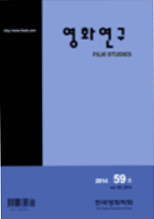- 영문명
- Defining Taiwanese Identity from the Past and Realities: New Taiwan Cinema, 1982-1996
- 발행기관
- 한국영화학회
- 저자명
- 정태수
- 간행물 정보
- 『영화연구』제53호, 333~378쪽, 전체 46쪽
- 주제분류
- 예술체육 > 예술일반
- 파일형태
- 발행일자
- 2012.09.30
8,320원
구매일시로부터 72시간 이내에 다운로드 가능합니다.
이 학술논문 정보는 (주)교보문고와 각 발행기관 사이에 저작물 이용 계약이 체결된 것으로, 교보문고를 통해 제공되고 있습니다.

국문 초록
영문 초록
Taiwan New Cinema continued for a long period, from 1982 when did appear In Our Time, a anthology film by Tai Te-Chen, Edward Yang, Ko I-Chen, and Chang Yi to 1996 when Edward Yang made Ma Jiang. Taiwan New Cinema was formed by two different, but linked, processes of transform. The first was a set of films reflecting the problem of fact and reality that emerged among contemporary Taiwanese writers’ debates. The second was those films dealing with historical events and landscape that were prohibited during Chiang Kai-Sek’s regime. Both sets of films, although formed through different relationships, ultimately focused on the problem of Taiwanese identity. In this respect, it is not exaggeration that Taiwan New Cinema was a set of probings of Taiwanese politics, society, and culture in transition. The beginning of such cinematic exploration was In Our Time. Starting with this film, Taiwanese cinema began to escape from its traditional mode of style and production, a largely escapist cinema. It touched upon the sense of nostalgia throughout travel to childhood and critically explored materialism, solitude, loneliness, and absence of communication that occurred during the process of rapid economic growth in Taiwan. It also dealt with current social problems previously ignored or suppressed in the national cinema; it directly visualised Taiwanese history and identity which had been obscured by the tension between the native Taiwanese and mainland Chinese immigrants. Among others, Hou Hsiao-Hsien and Edward Yang casted countless problems toward Taiwanese identity, probing the modern history of Taiwan. This paper will have a close at the two processes in Taiwan New Cinema and explore its concerns and themes and its shared style.
목차
1. 신전영에 대한 경계 짓기
2. 향토문학논전, 산업화, 정치민주화
3. 과거를 통해 현실을 보고 대만의 정체성을 인식하다
4. 결론
키워드
해당간행물 수록 논문
- 신영균의 캐릭터와 연기 스타일 연구
- 저작권법 이용현황 분석에 따른 영화제작 환경의 효율적인 방안 연구
- 과거와 현실을 통한 臺灣의 정체성 찾기, 신전영(新電影, 1982-1996)
- 1910년대 경성의 극장과 극장문화에 관한 연구
- 영화 소개 프로그램의 사운드 전략 연구
- 박찬욱 감독의 국제적 평가에 관한 연구
- 영화적 개념의 탈영토화와 뉴미디어적 재영토화
- 카자흐스탄 최초의 무성영화 <켈린>에 재현된 고대 튀르크 전통과 텡그리(Tengri) 신앙
- 찬영회 연구
- 인터랙티브 다큐멘터리-미학적 분석과 그 의미
- 에이젠슈테인의 몽타주 개념에 대한 인식론적 고찰
- 작가주의 영화이론의 새로운 가능성을 위한 시론
- 영화전공 대학생의 진로탐색행동 연구
- 발리우드 영화의 전형으로서 <세 얼간이> 연출 분석
- 1960~70년대 일본영화의 새로운 특징에 관한 연구
참고문헌
관련논문
예술체육 > 예술일반분야 BEST
- 생성형 AI 도구와 디자이너의 협업 프로세스 개발 - 이미지를 통한 아이디어 확산에서 고해상도 렌더링까지
- 디자인 전공 교과목에서의 생성형 AI 도구 활용 사례 연구
- ‘일과 삶의 균형(Work-Life Balance)’ 척도 개발을 위한 연구
예술체육 > 예술일반분야 NEW
- 영화연구 제105호 목차
- 디지털 숏폼 시네마의 감각적 전환: 포스트-연속성과 플랫폼 디스포지티프
- 생기적 물질론으로 본 에코시네마의 물질적 전회: 하마구치 류스케의 <악은 존재하지 않는다>를 중심으로
최근 이용한 논문
교보eBook 첫 방문을 환영 합니다!

신규가입 혜택 지급이 완료 되었습니다.
바로 사용 가능한 교보e캐시 1,000원 (유효기간 7일)
지금 바로 교보eBook의 다양한 콘텐츠를 이용해 보세요!



